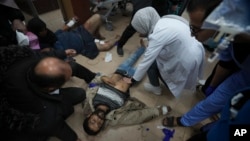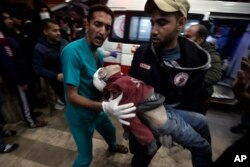World Health Organization officials warn a humanitarian and health catastrophe is unfolding in the Gaza Strip as the humanitarian space for providing life-saving treatment and aid is shrinking.
“At the same time that we are seeing this humanitarian catastrophe unfold before our eyes, we are seeing the health system collapse,” said Sean Casey, WHO Emergency Medical Teams Coordinator.
“Hospitals are closing, patients are lacking access to health facilities, health workers are being forced to flee for their safety,” he said, adding that people could be treated and lives could be saved, “if they had access to care.”
Casey, who has been in Gaza for the past five weeks, described seeing “a dramatic interruption in health services and a dramatic loss of access to health care workers.
“There are hundreds and thousands of patients awaiting surgery and it continues to be a shrinking of humanitarian space, and a shrinking of health services across the Gaza Strip,” he said.
Speaking to journalists from Rafah Tuesday about a recent visit to Al-Aqsa Hospital, he described conditions there as shocking, with only a skeleton crew available to care for large numbers of sick and war-wounded.
“When I visited and walked through the emergency department, I saw once again as I have seen in hospitals across Gaza over the last five weeks, patients being cared for on the floor.
“When I was there on Sunday, it was mostly children with gunshot wounds, with shrapnel injuries. Children who were playing in the street when the building next to them exploded. They were waiting, in some cases an hour or more just to be seen, with serious injuries bleeding on the floor and with just a handful of doctors and nurses there to care for them.”
Gaza’s Hamas-run Ministry of Health says at least 23,084 Palestinians have been killed in Gaza, 70% of whom are women and children, since Hamas terrorists brutally invaded Israel October 7, killing more than 1,200 people and abducting some 240 hostages. During the same period, 58,926 Palestinians reportedly have been injured.
“We are talking about 3.5% of the population very much directly affected,” said Rik Peeperkorn, WHO representative for the occupied Palestinian territory.
Speaking from Jerusalem, he said, “I want to say something also about the injured. We talk about multiple trauma cases, patients with multiple traumas, spinal trauma, terrible injuries, severe burns, amputees.
“I have never seen so many amputees in my life, including among children, which, if you think about it, not only the patients themselves, but the families and community means that this will have a long-term impact for everything.”
Peeperkorn also described the difficulty of getting humanitarian supplies into Gaza, and the inability of getting humanitarian aid and workers within Gaza to reach people in need.
“As long as there is no cease-fire, humanitarian corridors are required within Gaza to make sure that aid gets through,” he said. “Hostilities and evacuation orders in neighborhoods of the middle area and Khan Younis, Gaza are affecting access to hospitals for patients and ambulances and making it incredibly complex for WHO to reach those hospitals to provide supplies and fuel.”
The European Gaza Hospital, Nasser Medical Complex and Al-Aqsa Hosptial, he said, are near evacuation zones.
“These three hospitals are a lifeline in the south, where about two million people are present,” said Peeperkorn. “What we see is that the constricted flow of supplies and access, and the evacuation of medical staff from many hospitals due to fears for safety, is a recipe for disaster and makes more hospitals non-functional, as witnessed in the north.”
The WHO, which has documented 590 attacks on health care facilities in the occupied Palestinian territory since October 7, has been forced to cancel six planned missions to northern parts of the Gaza Strip since December 26.
The organization has also reported that 304 attacks in the Gaza Strip have resulted in 606 fatalities and 774 injuries. The attacks have affected 94 health care facilities, including damage to 26 of 36 hospitals in Gaza.
According to UNRWA, the U.N. Relief and Works Agency for Palestine Refugees, some 1.9 million people, or nearly 85% of the total population of Gaza, is internally displaced.
“Many have been displaced multiple times,” said the WHO’s Sean Casey. “Here in Rafah where I am, people are sleeping under tarpaulins, under makeshift tents, under incredibly crowded conditions.
“These people lack access to primary health care. There is no secondary or tertiary hospital close by that is accessible,” he added. “So, people are moving from one bad situation to another. There is no hospital in Gaza where you can go and expect to get care with certainty.”
Casey also said hospitals are bursting at the seams with patients suffering from hunger, numerous infectious and chronic diseases as well as horrific war injuries, many requiring surgery, including amputations.
Casey said that when patients do manage to reach a hospital there are so few medical professionals available that “their initial focus is damage control, which is keeping people alive.”






